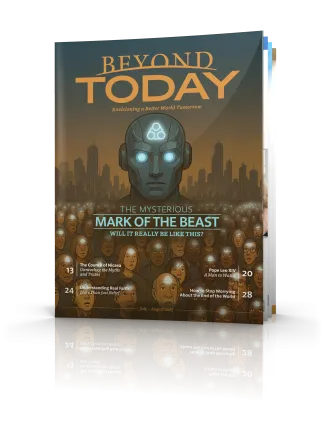The Mysterious Mark of the Beast: Part 2 - The Mark and Number of the Beast

In this second of two parts, we examine the meaning of the mark of the Beast in Revelation along with the number 666. Is it some branded QR code or license for digital transactions? And just what relevance does this have to your life?
The preceding article identified the prophesied Beast in the book of Revelation as the Roman Empire and its tyrannical ruler, with a succession of revivals over the centuries culminating in one still to come. This political, economic and military system emerging in Europe will act in partnership with a false religious power centered at Rome, as occurred during a series of revivals in the past. (It’s recommended that the preceding article be read before this one.)
Now we turn to the specific matter of the actual mark of the Beast along with the number 666. As previously noted, many ideas have been bandied about regarding these. But what does the Bible say? Does history shed further light? And why should we concern ourselves with these questions?
The mark and number an important matter
In Revelation 13:16-17 we see the introduction of the infamous mark, as the religious power causes all “to receive a mark on their right hand or on their foreheads, and that no one may buy or sell [transact business] except one who has the mark or the name of the beast, or the number of his name.” Revelation 13:18 continues: “Here is wisdom. Let him who has understanding calculate [or count] the number of the beast, for it is the number of a man: His number is 666.”
So this is ultimately a very important matter—one of spiritual wisdom that is also mentioned in several other passages of the book. Those who receive it will drink of God’s wrath, while the resurrected saints are those who are victorious over the Beast, the image, the mark and the number of the Beast (Revelation 14:9; Revelation 15:2; Revelation 16:2; Revelation 19:20; Revelation 20:4).
Do you want to live and reign with Christ? Then don’t receive this mark. That doesn’t mean you can’t receive it and then repent. That’s part of the message of this book too. Revelation 18:4 tells people to come out of the false Babylonian system to avoid suffering her plagues of divine judgment. That means people who are part of this system can and must leave it behind.
That brings us back to the question of what this mark is. It’s true that we’re seeing a rise of technology and data to surveil society, giving governments much more control over people’s lives. They can categorize us, knowing what we believe in and support. Eventually this will probably become even more systematized—so that what employment we’re able to hold or what business we are able to do is contingent on whether we are flagged as a problem person who does not go along with the system.
There may be an aspect of this in the mark described here—in how the Beast system is able to monitor all this and enforce control over what people do. But is that really what the mark itself is? Is it a barcode on your hand or forehead or an implanted microchip? Based on broader evidence from Scripture, that does not seem to be the case. Perhaps that will be how authorities are able to keep tabs on people to impose their controlling system.
But, as we’ll see, something that well fits the description of the mark of the Beast has existed in the past before there was electronic surveillance. Before going to that, though, let’s consider what the Bible itself says elsewhere about receiving a mark in your hand and forehead.
God’s laws in our hand and forehead as a sign
In Deuteronomy 6:6-8 God said of His commandments, “You shall bind them as a sign on your hand, and they shall be as frontlets between your eyes.” The Jewish people later took this in a literal sense, tying phylacteries—small boxes containing the verses here—to their hands and forehead. But this was never meant to be done literally. We can see that from Exodus 13, where the observance of the Feast of Unleavened Bread and the practice of dedicating all firstborn to God were to likewise be signs on the people’s hands and between their eyes (Exodus 13:7-9; Exodus 13:11-16). You don’t tie unleavened bread or the firstborn to your hand and head. This was meant in a figurative sense.
The fact that you do what’s commanded is what’s in your hand, symbolizing your actions. And between your eyes refers to your brain, your mind, what you think with, the source of your actions. So it really means in your thoughts and in your deeds—your allegiance and the way you live. It’s speaking of keeping these festivals—and in Deuteronomy 6 all that God commands us to do. And note that it’s to be in your forehead and hands, your thoughts and actions, as an identifying sign—like a mark—declaring our worship of the true God alone. (See also Deuteronomy 11:13-23.)
Some matters of obedience will distinguish us more than others. God particularly declared His Sabbath rest days to be such a sign—the seventh-day weekly Sabbath (from Friday sunset to Saturday sunset) along with the annual Holy Days among His festivals—showing that He is our God and we are His people (Exodus 31:12-17).
Regarding the more literal interpretation many give to the mark of the Beast, we should ask: Is it wrong to have a credit card? Is it wrong to use digital currency? Is it wrong to have some form of identification issued by the government? Not of itself. A permanent tattoo would be another matter. And there could well be an issue with ceding personal sovereignty to and displaying participation in what is believed to be an evil system. If someone believes something is wrong and still does it, that would be a sin in terms of intent. But there’s nothing that specifically forbids bearing some kind of scannable data stamp or microchip—or vaccine markers or a digital currency key.
Choosing between right and wrong is a matter of obedience to God’s commands. And we have all these examples of the matter of obedience in our thoughts and actions as constituting an identifying sign. Clearly, that is also the issue with the mark of the Beast.
In contrast to the Beast and religious power having blasphemous names on their foreheads (Revelation 13:1; Revelation17:3-5), God’s people are shown to be sealed in their foreheads with the name of God (Revelation 7:2-3; Revelation 14:1; Revelation 22:4). Angels holding back destruction until God’s servants are sealed (Revelation 7:1-4) parallels a vision in Ezekiel 9 of God’s faithful people who are upset with the evil society around them receiving a mark in their foreheads for their protection when the society’s destruction comes (Ezekiel 9:4-7).
Other passages show God’s people to be sealed with the Holy Spirit (2 Corinthians 1:21-22; Ephesians 1:13-14; Ephesians 4:30). There has to be an obedient mind-frame from repentance to receive the Spirit (Acts 2:38). And then that Spirit helps us to continue to obey (compare Romans 5:5; 1 John 5:3), with God writing His laws in our hearts and minds (Jeremiah 31:33; Hebrews 8:10; Hebrews 10:16). Again, this all comes down to keeping God’s laws—following God and obeying Him.
False church decrees dissenters unfit to participate in society
As we saw, the false Christian system promotes lawlessness or disobedience to God’s commands, although it upholds some and mandates others different from those found in the Bible. The false church and its leader are synonymous with the blasphemous “little horn” that springs up among the Roman civil powers in Daniel 7. It would bring terrible persecution on God’s people, having determined “to change times and law” (Daniel 7:25).
This is a very big key. It would seek to change the laws of God—and not just in general but specifically laws relating to time, with the saints not going along with this and suffering as a consequence. And indeed the false system has made many major changes in the times God has commanded us to observe and the manner of observance. The observance of God’s Sabbaths and festivals commanded in the Bible is quite different from the observances of this worldly system.
The whole foundation of the false religious system is paganism, especially that coming from ancient sun worship. By the power of the Roman state, the false church outlawed resting on the seventh-day Sabbath and the biblical festivals, scorning them as Jewish, and imposed the weekly observance of “the day of the unconquered sun,” Sunday, and other pagan festivals throughout the year, chief being what became Christmas and Easter. This was a rejection of what God had given as an identifying sign between Him and His followers.
Now consider the false system’s treatment of dissenters, including God’s true followers, especially beginning with Roman Emperor Theodosius II declaring Roman Catholicism the official religion of the empire and the reiteration that came under Justinian’s imperial restoration.
Will Durant wrote regarding the Code of Justinian: “This Code, like the Theodosian, enacted orthodox Christianity into law. It began by declaring for the Trinity . . . It acknowledged the ecclesiastical leadership of the Roman Church, and ordered all Christian groups to submit to her authority . . . Relapsed heretics were to be put to death; Donatists, Montanists, Monophysites, and other dissenters were to suffer confiscation of their goods, and were declared incompetent to buy or sell, to inherit or bequeath; they were excluded from public office, forbidden to meet, and disqualified from suing orthodox Christians for debt” (Vol. 4, p. 112, emphasis added throughout).
Such treatment persisted throughout the Middle Ages under the Holy Roman Empire. Note these words of an edict from Pope Alexander in 1163 at the Council of Tours concerning those labeled heretics:
“Whereas a damnable heresy has for some time lifted its head in the parts about Toulouse, and has already spread its infection through Gascony and other provinces, concealing itself like a serpent within its own folds; as soon as its followers shall have been discovered, let no man afford them a refuge on his estates; neither let there be any communication with them in buying or selling; so that, being deprived of the solace of human conversation [or interaction], they may be compelled to return from error to wisdom” (quoted by George Waddington, A History of the Church, Vol. 2, 1833, p. 356).
In both cases those who don’t go along with the false system are not allowed to buy and sell—as was directly foretold of the enforcement of the mark of the Beast.
Consider that this was decreed long before there was any conception of implanted microchips, barcodes or other modern surveillance technologies. An effective marking of people to regulate participation of societal commerce was already there—a form of “cancel culture”—though obviously not on the technological level to accomplish it effectively on the scale we are able to have today and in the biggest way it will be manifested yet ahead. To what extent such technological surveillance is required to fulfill Revelation 13 is not totally clear, given that the Roman system was enforcing its mark to an extent for centuries before there was such technology.
Rejecting the Roman system and its rebellion against God
As to the number of the Beast, 666, it has been interpreted in various ways, and there may be layers to the meaning. But the directive we are given in Revelation 13:18 is to “count” like pebbles (Greek psephisato) the number of the name. This seems to refer to adding up the number values of letters in a name or other word, which was a common practice at the time John wrote. Numbers were represented by letters in Hebrew and Greek, as in the Roman numeral system where “I”=1, “V”=5, “X”=10, etc. Giving sum total values of words was part of the Hebrew practice of gematria and the Greek equivalent called isopsephy. Some Greek graffiti found at Pompeii reads, “I love her whose number is 545.”
Irenaeus, one of the early church fathers, says that Polycarp, who was a disciple of the apostle John, explained that 666 was the total in adding up the number values of the letters in the Greek word Lateinos, meaning “Latin man,” the Greek term for Roman (Revelation and the rest of the New Testament being written in Greek). Revelation calls it the number of the Beast and the number of a man and says the number is of the name. Here we have the Greek name of the empire and of every man in the empire, including its leader and its powerful church. These all bear the name Roman. This is very telling. (Other summations associated with the Roman system have been noted as well, but limited space prevents discussing them here.)
Clearly this is identifying the powerful Roman system of rule and worship, which is all about sun worship and emperor worship and denying people from obeying the true God, from walking in what’s right. This is what the mark of the Beast comes down to.
Concerning the transfer of the weekly Christian worship day from the biblical seventh-day Sabbath to the day of the sun, Sunday, the Roman church has in the past claimed this as having been done by its own authority superseding the Bible—and has argued that Protestants, having accepted Sunday observance begun by Rome, are simply continuing under Roman church authority. At the end of the 19th century, H.F. Thomas, chancellor of Cardinal Gibbons, wrote in reply to a letter about the switch to Sunday: “Of course the Catholic Church claims that the change was her act . . . And the act is a mark of her ecclesiastical authority in religious things” (Nov. 11, 1895). Note this change of times and law as a mark of her authority!
Much of Europe today is very secular, but in Germany, the most powerful European Union nation, Sundays remain sacred, especially in smaller towns. Many Sunday laws are still in effect in Europe. A papal encyclical in 2000 called for Sunday as a unifying day of rest to help save the environment—popular motivation in the secular world. On the other hand, we have not seen any push to require people to work on the Saturday Sabbath. Of course, there is often conflict with employment, school and other societal activities, Sabbath observance being regarded as a fringe position, with legal protections lacking or ignored.
Eventually signs and wonders in the false church and likely a backlash against Islamic ingress and terrorism will drive Europeans back to a more traditionalist position. This need not mean that other churches besides the Roman church will not be allowed to operate.
There has been a major push for ecumenism among various churches, with the Roman church leading the way, trying to bring everyone back into what’s seen as the one universal church (the word Catholic actually meaning “universal”). This would seem to require that some differences in teaching be allowed, but on some things everyone would have to agree. There already exists today among various churches a “Lord’s Day Alliance,” which says that Sunday is the mark of unity of Christian churches.
Those who observe the biblical seventh-day Sabbath and reject Sunday and the pagan-rooted holidays of Christmas and Easter will likely be people labeled as cult members who are outside the accepted mainstream and, worse, dangerous people who must be guarded against and dealt with. We’re already seeing this kind of thing with the spreading of cancel culture.
What we’re really talking about in terms of the mark of the Beast is not just the Sabbath vs. Sunday. That’s an identifiable part of it—something that could put true Christians more visibly in conflict with the state in union with the false church. But receiving God’s sign and rejecting the mark of the Beast involve all of God’s laws. Are we following God? Are we obeying Him? Are we keeping what we’re told to do?
If we’re doing that, we will not receive the mark of the Beast—the mark of disobeying God under the tyranny of Satan.
The main and ultimate enforcement of the mark of the Beast will not come until the final 3½ years leading up to Christ’s return has begun. We are not there yet. But there may be precursors leading up to that—just as there have been in the Roman system in past centuries. And we must remain vigilant.
The coming Great Tribulation will be worse than any time we’ve seen before. But in the end, God’s people will be granted victory over the Beast and its mark, having instead God’s name on their foreheads, with His laws as a sign in their minds and actions.
Reject the mark. Come out of Babylon. Obey God’s commandments. And bear His name forever!






